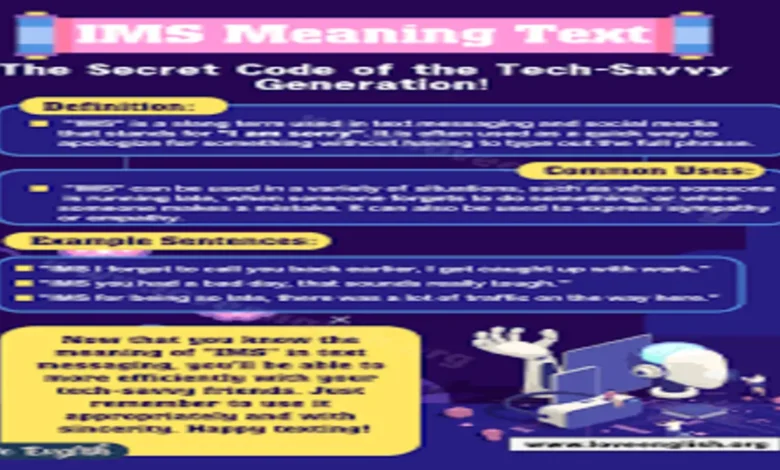IMS Meaning Text: Exploring the Depths of Instant Messaging Acronyms

Introduction to IMS Meaning Text
In the world of digital communication, acronyms, and shorthand phrases have become an integral part of the way we interact online. Among these, IMS stands out as a commonly used abbreviation, especially in text messages and social media platforms. IMS, which typically stands for “I’m sorry” or “Instant Messaging System,” can hold varying meanings depending on the context in which it is used. This adaptability is one of the reasons it has gained popularity, as it seamlessly fits into conversations that range from casual chats to professional exchanges.
Understanding the true essence of IMS is about more than just its definition. It’s about delving into how it is applied in real-world scenarios and why people prefer using such abbreviations. This exploration can reveal a lot about the evolution of online communication and the subtle ways it influences our interactions.
The Origins of IMS
The abbreviation IMS didn’t emerge overnight. Its roots can be traced back to the rise of instant messaging platforms like AOL Instant Messenger (AIM), MSN Messenger, and Yahoo Messenger in the late 1990s and early 2000s. These platforms introduced users to a faster and more dynamic form of communication that necessitated brevity.
IMS was initially used to refer to the broader “Instant Messaging System,” a nod to the platforms facilitating these interactions. Over time, as texting culture evolved, it morphed into a shorthand for personal expressions like “I’m sorry,” further proving its versatility. IMS’s ability to transcend platforms and generations makes it a unique acronym in the digital lexicon.
IMS in Casual Conversations
When it comes to casual texting, IMS is often a way to convey emotions or apologies quickly. For instance, if someone realizes they made a mistake or overlooked something important, sending a quick “IMS” can immediately soften the tone of the conversation. This application has grown popular because of its simplicity and ability to maintain the flow of casual chats without lengthy explanations.
Another reason for its widespread use is that abbreviations like IMS make conversations feel more personal and relatable. In a digital age where rapid responses are the norm, users gravitate toward shortcuts that still carry meaning. IMS fits this bill perfectly, acting as a bridge between sincerity and efficiency.
Professional Contexts for IMS
While IMS is primarily a casual abbreviation, it has also found its way into professional environments. Here, the meaning usually returns to its original form, “Instant Messaging System.” Companies and organizations often refer to their internal chat platforms or tools like Slack, Microsoft Teams, or Google Chat as their IMS.
In professional settings, the IMS is a critical tool for collaboration, allowing team members to exchange information quickly and streamline workflows. This context shows how acronyms can adapt based on the environment, highlighting their multifaceted nature.
Moreover, using IMS in professional contexts emphasizes how language evolves with technology. What began as a term for personal chats has become a cornerstone of modern workplace communication.
The Psychological Impact of Using IMS
Using acronyms like IMS isn’t just about saving time; it’s also about the psychological nuances of communication. Abbreviations can make messages feel less formal, reducing the potential stress or tension in a conversation. For example, apologizing with “IMS” may feel less daunting than typing out “I’m sorry,” particularly in situations where emotions are high.
This dynamic is especially evident among younger generations, who tend to favor abbreviations as a way of connecting on a more casual level. The reduced effort required to type out acronyms aligns with the fast-paced, multitasking lifestyle that many people lead today.
Common Misinterpretations of IMS
As with any abbreviation, IMS is not immune to misinterpretations. While the primary meanings of “I’m sorry” and “Instant Messaging System” are widely recognized, there are instances where context can blur its intended use. For example, someone unfamiliar with the term might interpret IMS as something entirely unrelated, such as “In My Sights” or “I’m Sure.”
This variability underscores the importance of context in digital communication. Acronyms thrive on shared understanding, and when that is missing, misinterpretations can arise. Clarifying the intended meaning of IMS when there’s doubt can prevent confusion and ensure that the conversation stays on track.
IMS and Its Role in Digital Trends
The role of IMS in shaping digital trends cannot be overstated. As part of a broader movement toward concise communication, acronyms like IMS highlight society’s shift toward efficiency. The rise of platforms like Twitter, with its character limits, and the dominance of instant messaging apps have further cemented this trend.
IMS represents the intersection of technology and linguistics, illustrating how the tools we use influence the language we speak. This relationship is a fascinating area of study for anyone interested in the evolution of communication in the digital age.
How to Use IMS Effectively
For those looking to incorporate IMS into their communication, understanding the context is key. In casual conversations, it works best when the tone is light and informal. Using IMS as an apology, for instance, is effective when both parties are familiar with the abbreviation and its intended meaning.
In professional settings, referencing IMS as an “Instant Messaging System” requires clarity. While most workplaces have their own established acronyms and terminologies, ensuring that everyone is on the same page about what IMS stands for can prevent misunderstandings.
The Future of IMS
As digital communication continues to evolve, so too will the role of abbreviations like IMS. With the advent of AI-driven chat platforms and the integration of messaging tools into virtual reality environments, the need for concise communication is more relevant than ever. IMS, in all its forms, will likely remain a staple of online interactions, adapting to new contexts and technologies.
The future may also see IMS being used in ways we can’t yet imagine, as language and technology progress hand in hand. Whether it’s through emerging platforms or shifting cultural norms, IMS is poised to remain a dynamic and versatile tool in our digital lexicon.
Conclusion
IMS meaning text is a testament to the adaptability of language in the digital age. From its origins as an “Instant Messaging System” to its casual use as an “I’m sorry,” IMS embodies the flexibility and creativity of modern communication. Its ability to convey meaning in just a few characters makes it an invaluable tool for both personal and professional exchanges.
As we look ahead, IMS will undoubtedly continue to shape the way we connect and interact. By understanding its meanings, applications, and nuances, we can better appreciate the role it plays in our everyday lives. Whether you’re a seasoned texter or just discovering the world of digital abbreviations, IMS is a reminder of how small things can have a big impact.




